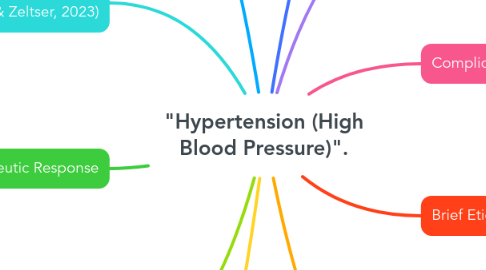"Hypertension (High Blood Pressure)".
by Shaibu h


1. Lifestyle Approaches (Dilonardo, 2022)
1.1. Diet: Healthy diet rich in vegetables, fruits, and low-fat foods Exercise: Regular physical activity Weight Management: Maintaining a healthy weight Limiting Alcohol: Reducing alcohol intake Quit Smoking: Reducing tobacco consumption Reduce Stress: Relaxation techniques
2. Common Classification of Medication (Khalil & Zeltser, 2023)
2.1. Diuretics ACE Inhibitors (Angiotensin-Converting Enzyme Inhibitors) Example: Lisinopril (Lopez et al., 2023) Mechanism: Reduces production of angiotensin II, causing vasodilation and minimizing blood pressure Calcium Channel Blockers
3. Therapeutic Response
3.1. Lower blood pressure Reduced risk of stroke and heart attack Improved heart function
4. Necessary Safety Information
4.1. Monitoring
4.1.1. Regular blood pressure checks Avoid excessive heat and stay hydrated Inform healthcare providers of any medical complications
4.2. Special Monitoring
4.2.1. Renal Function: Regular tests (Serum Creatinine and BUN) Blood Pressure: Regular monitoring Serum Potassium Levels: Monitor for hyperkalemia (normal range: 3.5-5.0 mEq/L)
5. Symptomps to Report
5.1. Swelling lips, face, throat, or tongue Severe dizziness High potassium signs Difficulty in urinating
6. Definition
6.1. Chronic condition with high blood force against artery walls (140/90 mmHg or higher) (World Health Organization, 2023)
7. Symptoms
7.1. Often asymptomatic Shortness of breath Severe headaches Flushing Nosebleeds Chest pains Dizziness Visual changes
8. Complications
8.1. Stroke Heart disease Kidney failure
9. Brief Etiology
9.1. Factors
9.1.1. Lifestyle choices Genetic predisposition Various health issues
9.2. Contributing Factors
9.2.1. Lack of physical activity High sodium diet Stress Obesity
